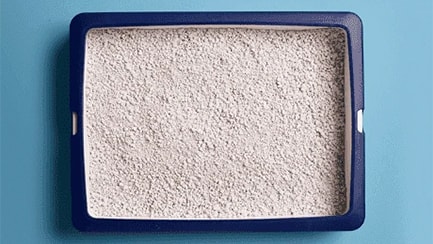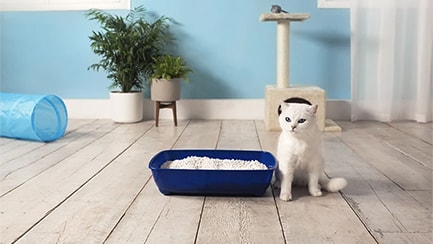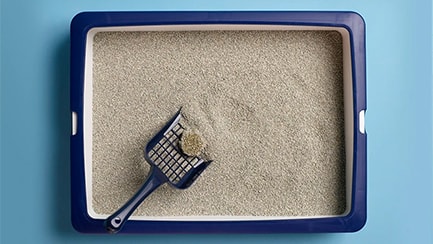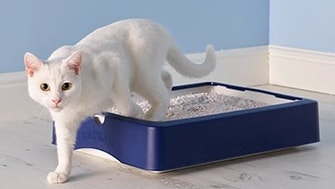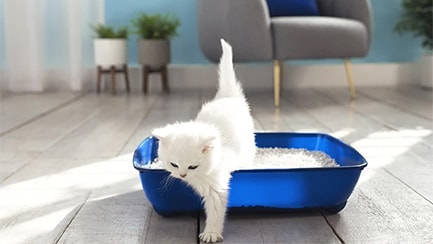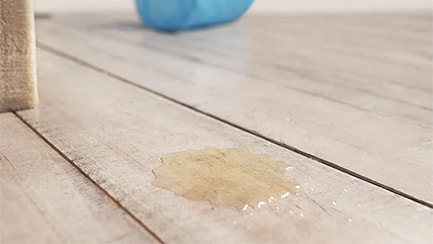FAQs
-
Where should I place the litter tray and why?
Just like humans, cats like a bit of peace and privacy when they go to the toilet, so try to place your cat’s litter tray in a quiet place. Make sure it’s not near their food or water bowl either – cats are way too clean and fussy to want to go to the toilet close to where they eat!
Finally, bear in mind that your cat’s litter tray should be easily accessible to them. If you’ve got a senior cat, for example, this could mean not putting their litter tray upstairs or in the basement so they don’t have to contend with stairs every time they need the loo.
What kind of litter trays are best?
Litter trays come in all shapes and sizes and ultimately it’s a matter of finding the one your cat likes best, but do make sure it’s big enough for them to move around freely and turn 360°. If you have a kitten or an older cat, you need to make sure the edges aren’t too high for your feline friend to easily get in and out.
Why do some litter trays have a hood?
Some cats like the privacy that a hooded litter tray affords, although others feel safer with a clear view of their surroundings and any ‘threats’.
From an owner’s point of view, a hood means you don’t have to look at the litter. It can also be useful for trapping odours and prevent your cat from scattering the litter over the floor when digging.
Do I need a litter tray if I have an outdoor cat?
Even if your cat has access to the outside world, it can be a good idea to have a litter tray in the house. This gives your cat choices and stops them ‘holding on’ because it’s pouring with rain or the neighbour’s dog is outside.
How many litter trays do I need?
Cats don’t like sharing their litter tray with other cats, which is why you should have at least one litter tray per furry friend and ideally one spare one as well.
If you have a kitten, you might want to consider having a litter tray in every room. Just like small humans, kittens can get caught up in playing and not realise they need to pee until the last minute!
I’ve heard that some cats like one litter tray to pee and another to poo. Is that true?
It can be true! If in doubt, provide your feline friend with more litter trays than you think they need.
What are the advantages of automatic cat toilets?
Automatic cat toilets can save owners hassle and time by doing the daily cleaning so you only have to empty the storage compartment about once a week (depending on capacity). As most automatic cat toilets have a hood, this, in addition to the self-cleaning cycle, can result in less dust and odours. Some cats actively dislike the noises they make though.
If you do go for an automatic cat toilet, make sure you check the user’s manual to see which litter they recommend.
What’s the best type of litter scoop?
The material, colour and shape of the scoop you use comes down to personal preference but it’s important to choose one that has the correct size of grid. It needs to be large enough to let unused litter granules pass through but small enough to hold back faeces or urine clumps.
How often should I change the litter?
Cats are very clean animals with a highly developed sense of smell so it’s important to keep things just so. Scooping the litter box at least once a day and then giving it a thorough clean and fresh litter once a week is a good guideline, but there are lots of factors to take into account. You’ll have a different cleaning routine if you use clumping or non-clumping litter, for example, and you’ll obviously need to do more litter tray changes if you have more than one cat. You might also want to change the litter more often depending on where it is in your home, particularly if it’s in your kitchen (although do bear in mind that cats have a very strong sense of smell so they’ll want a nice fresh litter tray even if it’s placed somewhere where whiffs don’t bother you as much).
Ultimately your cat’s behaviour is one of the best indicators of whether you’re cleaning the litter tray often enough. If they’re using it happily, then you’re probably getting things right.
How should I clean the litter tray and what products should I use?
Empty the litter tray and then give it a thorough wash using a mild, non-scented detergent. Avoid using any products that contain ammonia, bleach or any type of caustic ingredient.
Keeping a little bit of the unsoiled old litter and mixing this in with the new will mean the litter tray smells familiar (and therefore acceptable!) to your cat.
How much litter should I add to a tray?
Follow the instructions on the side of the pack. For Catsan™ Hygiene litter this is about 5cm and for Catsan™ Natural Clumping litter it’s about 6cm.
Of course, this is only guidance and how much litter you use is down to your cat (naturally!) and how enthusiastic they are about digging. The right amount of litter allows your cat to dig and cover which is a natural feline behaviour. If you don’t put enough litter into the tray, your cat may well refuse to use it and, if they do, urine will not be properly absorbed making it smelly. Too much litter isn’t a good idea either as it’s wasteful.
What size litter tray is ideal for kittens? What about adult cats? And what about seniors?
Your cat’s litter tray should be about one and a half times the length of the cat from its nose to the base of its tail. This means they have enough space to move around, dig and cover.
A standard box of 50 x40 cm should be fine for most adult cats then (unless they’re a Coon or another big cat) and a smaller box of 40 x 30 cm should be suitable for a kitten.
A word on senior cats: While they won’t need a different sized litter tray you should make sure the sides aren’t too high for them to get in and out easily, particularly if they have arthritis.
Can I hide the litter tray in furniture (like a cupboard with an access hole)?
Hidden litter trays are a growing trend and popular with design conscious owners. Do make sure the litter tray is still easy for your cat to access though and (as with any litter tray) make sure it’s in a quiet part of the house and not near your furry friend’s food and water.
Is it better for cats to go outside or use litter?
If you cat goes to the toilet outside, this will obviously mean less cleaning for you although the trade-off is having stinky gifts left in your garden and your neighbour’s garden!
From your cat’s perspective, going outside gives them more freedom to choose their elimination areas.
Using litter can help you to monitor your cat’s health as you’ll quickly be able to spot problems such a blood in urine or litter avoidance.
There’s also a strong argument that even a cat who has access to the outside should have a litter tray. This gives your furry friend choices and means they don’t have to venture outside if they don’t feel like it.
How can I make the litter for my cat as ‘natural’ as possible?
Some litters are made with plant based raw material, such as corn kernels, walnut shells or wood. They might be developed without any chemical odour-masking agents and be biodegradable.
All Catsan™ litters use natural raw materials and are free from artificial additives. CATSAN™ Natural Litter is a great plant-based litter which is made with a by-product of wheat milling that would otherwise go to waste. This litter naturally binds odours into clumps and is 100% biodegradable.
Whatever litter you use, it’s important to bear in mind that being able to bury their ‘gifts’ is natural behaviour for your cat! In order for them to do this, their cat parent needs to make sure there’s always enough litter in the tray. This is about 5 -7cm but it’s best to check the instructions on the side of the pack.
Popular articles

